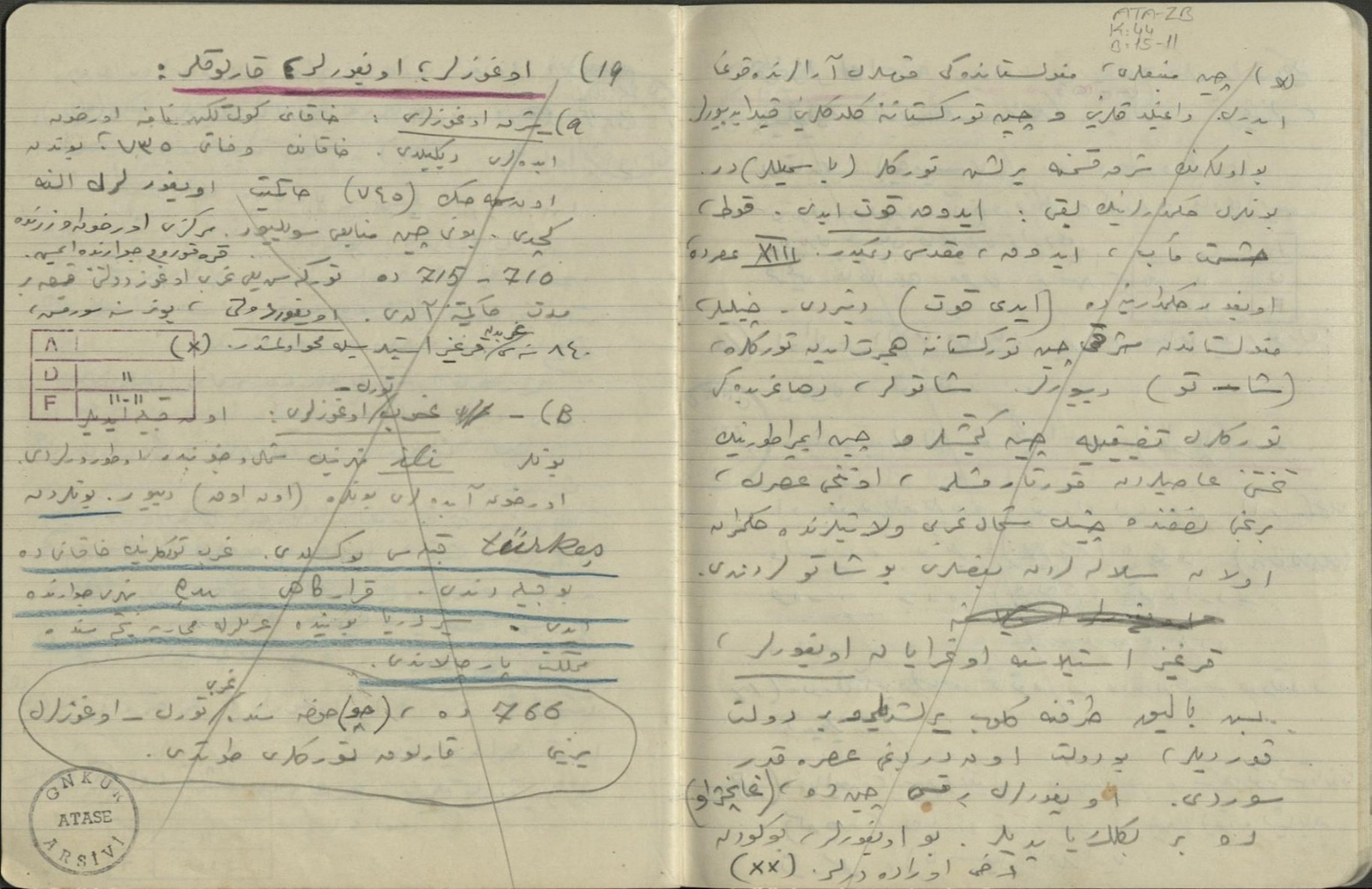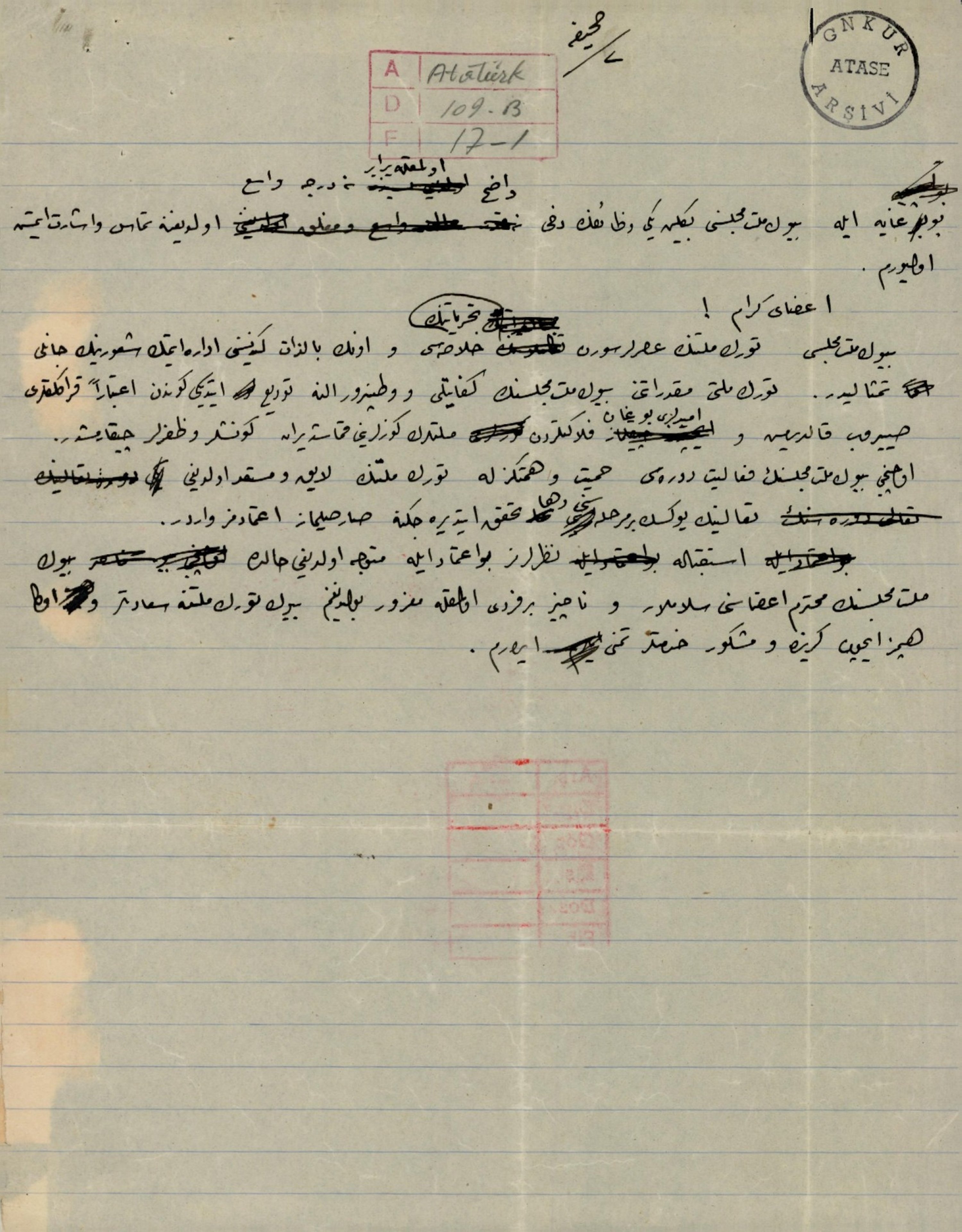© Turkuvaz Haberleşme ve Yayıncılık 2024
The collection of documents associated with the republic's founding figure, the great leader Mustafa Kemal Atatürk, has garnered attention since being transferred from the Directorate of Management Services of the Ministry of National Defense to the Presidential State Archives (ATASE).
Particularly striking are Atatürk's handwritten notes found within this collection.
From April 20, 2020, onwards, a total of eight collections, including the Atatürk Collection, for which the classification process had been finalized at the General Directorate of Management Services of the Ministry of National Defense, were made accessible to researchers.
Among the documents, one can find Atatürk's succinct handwritten notes on various subjects, including Central Asian Turkic history, the Huns, Göktürks and Uighurs, which he recorded back in 1907.
It's evident that Atatürk meticulously compiled information on Turkic history, from the Orkhon Inscriptions to the East Turks, the Turkic way of life, their migration to the Caucasus and Anatolia, and the establishment of the earliest Turkic states. This comprehensive collection employs a mix of Ottoman Turkish and, occasionally, Latin script.
In a conversation with the Anadolu Agency (AA) news agency, historian Osman Köse highlighted Atatürk's profound interest in Turkic history. He noted that Atatürk was an avid reader and would jot down notes around the margins of his books, often transcribing these thoughts in his own handwriting. Köse explained that one such set of notes pertains to Central Asian Turkic history, now preserved in the archives. Atatürk's notes are in Ottoman Turkish but are peppered with Latin script, particularly where Latin letters could better aid pronunciation or comprehension.
"Atatürk extensively delved into the early phases of Turkic history in Central Asia, spanning from the earliest periods up to the 10th, 11th, and 12th centuries, encompassing the Seljuk and Ottoman eras. Within this broad scope, he read extensively and meticulously recorded significant aspects. Notably, he delved deeply into Turkic-Chinese relations, the struggles against the Chinese, and meticulously studied the Turkic states established during periods of conflict with China in Central Asia," he said.
Köse also shed light on Atatürk's deep engagement with topics such as the Huns, Göktürks and Uyghurs. Notably, Atatürk's notes extend to periods even further back in history, detailing the migration of Turks to Europe during the Avar period. Köse underlined that the precision of dates in these notes is striking, as Atatürk meticulously documented rulers' reigns and the states' eras.

Interestingly, these archives also encompass Atatürk's notes on his speeches in the Grand National Assembly of Türkiye (TBMM). Köse highlighted a speech in which Atatürk expressed gratitude and conveyed his dedication to fulfilling his responsibilities as president with unwavering determination. Atatürk's words resonate with the principles of independence, nationhood and victory, stressing the republic's progress over its first four years.
"I believe it's a historic speech," stated Köse.
He continued: "In Atatürk's notes, it's evident that he emphasized the presence of the republic, the high interest of the nation, and the constant readiness to defend against any internal or external event. He underscores that the foundations of the republic have firmly taken root. Over these four years, it becomes clear that the Turkish nation has embraced the form of governance that suits its unique characteristics and is deserving – namely, the republic. Atatürk also communicates that in the coming years, alongside the collective might of the Turkish nation and utilizing the available resources, the establishment of the Republic will persist."
Köse emphasized Atatürk's expressions on establishing numerous domestic and international friendships in the aftermath of the formation of the republic. "This holds great importance," Köse stated. "Given that there was a four-year-long war and, subsequently, a national struggle ... Engagements with the world's major powers, the establishment of a new state, and the dawn of a new era – these conditions mandated the forging of relationships with global nations."
"He underscores that this necessity has been fulfilled. Ultimately, he outlines the series of agreements, commencing with the Ankara Agreement in 1920, continuing with prior arrangements with Russia, and subsequently extending to agreements with the British and the French," he added.
Köse also drew attention to Atatürk's aspirations for the future that are embedded within the speech.

"In his notes, Atatürk asserts that the republic will progressively evolve, and its foundations are robust. He conveys that the Turkish nation's contribution to this stability is significant, as the people have rendered substantial support and embraced it. Mustafa Kemal Atatürk essentially demonstrates that within these four years, as the initial landscape of the republic emerged, the newly established Turkish state is now charting a course toward new horizons. There are no obstacles ahead, agreements have been reached with world nations, friendships have been established, and the sole remaining objective is to construct a prosperous state and society," he elaborated.
Within the eight collections accessible to researchers, one can explore a wealth of documents.
This includes information about the positioning of Ottoman units around Istanbul, maps detailing the Italian bombardment and occupation of the Dardanelles and 12 islands, records concerning the recognition of Azerbaijan's and Georgia's independence by the Paris Peace Conference, and documents related to Mustafa Kemal's request for sunglasses without numbered frames from Tevfik Rüştü Bey.
Furthermore, the archives encompass a letter from an American traveler named John, praising Ankara's beauty, applauding the emergence of a new democracy, and extending congratulations to Mustafa Kemal Pasha.
